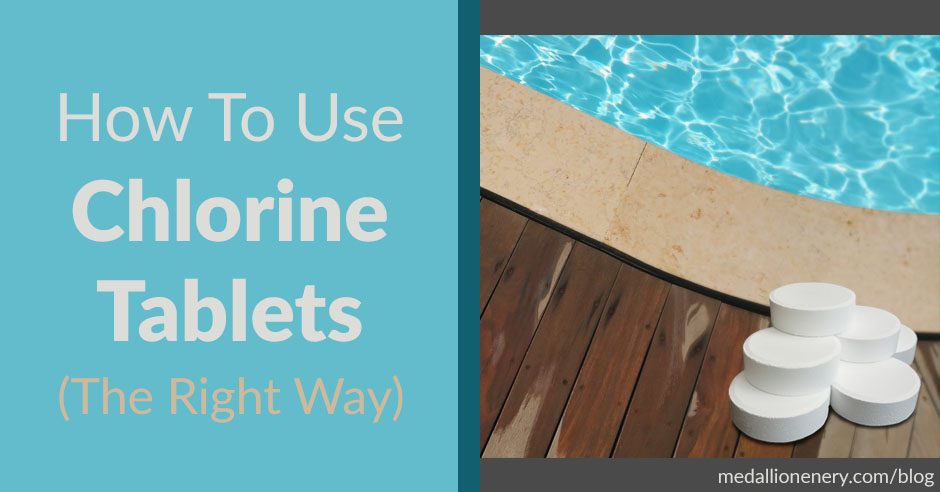Have a few questions about chlorine tablets? Want to know the best way to use them?
Keep reading to learn everything you need to know to get started
Owning a pool comes with its share of fun and responsibility. On one hand, you get to swim whenever you want. You can enjoy a cool, refreshing dip in the Summer, or heat up the water for a warm and cozy swim in the Fall. And a pool is the perfect spot for get-togethers, and spending time with family and friends.
But, if you want to actually enjoy your pool, then you have to keep it clean right? Because no one wants to swim in a dirty backyard pond.
So that means skimming the water, scrubbing the walls, vacuuming the floor, cleaning the filter, and so on. In other words, keeping your water visibly clean. But that still leaves the other side of pool care…
A pool that “looks” clean, isn’t necessarily clean to swim in. Seemingly clear water can be filled with micro bacteria and other contaminants. Which is exactly why products like chlorine tablets exist. As you know, chlorine is what sanitizes your pool and keeps it germ-free and safe.
And in this post, we show you how to use chlorine tablets in your swimming pool…the right way. Yes, despite their simplicity, there are right and wrong ways to use chlorine tablets. Using them the wrong way can damage your pool, and waste your money – which are two great reasons to keep reading this post.
So let’s do a quick rundown on chlorine tablets, and the best way to use them in your swimming pool.
Why pools need chlorine
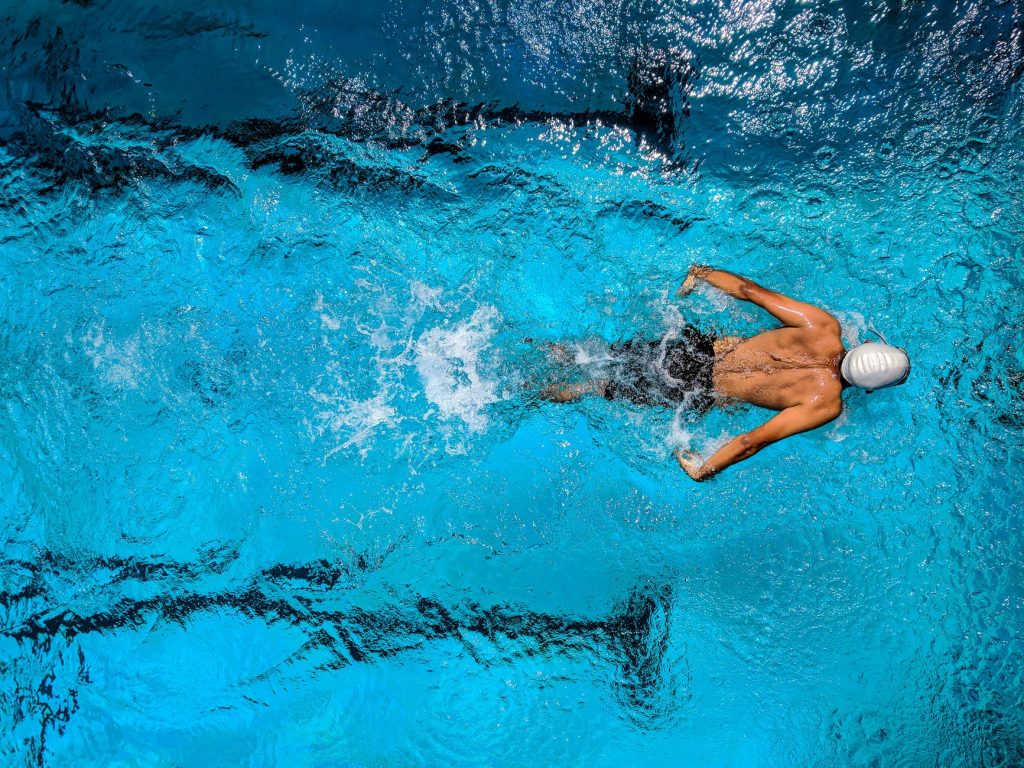


As mentioned earlier, chlorine is what keeps your pool safe and swimmable. It sanitizes your water and kills the germs, bacteria, and other contaminants that would otherwise pose health hazards.
But for those of you who want the nitty gritty details, here they are:
Chlorine ‘s sanitization process starts when it enters your pool. As it begins mixing with the water, chemical breakdowns occur. During these breakdowns, two important compounds are formed: hypochlorous acid and hypochlorite ions.
Both compounds actively sanitize your water by oxidizing the contaminants in your pool. But while hypochlorite ions are more “slow release” and oxidize over long periods of time, hypochlorous acid begins working on contact. Together, they keep your water germ free and safe for swimming in a variety of situations.
(Learn more about how chlorine works here)
So if you’ve ever wondered how it’s possible for a bunch of people to swim in a single rectangle of water without anyone getting sick, you can thank chlorine for that.
And on that note…
What chlorine tablets are used for
Chlorine tablets are a safe, effective, and affordable way to sanitize your pool. They’re designed to gradually dissolve, releasing chlorine into your water as they get smaller and smaller.
They’re a popular choice amongst pool owners because of how easy they are to use. For the most part, it’s as simple as putting them in your water and leaving them to do their job. Of course, where you put them matters, hence this entire post.
Unlike granular or liquid chlorine, there’s no precise measuring involved with tablets. So it’s much faster. Just add the right amount of tablets for your pool size, and your good to go in just a few seconds.
BUT, as we mentioned earlier, there are right and wrong ways to use chlorine tablets, which we’ll be getting to in just a minute.
For now, let’s talk about the different types of chlorine tablets you’ll find at the pool store.
Related: Balance Your Swimming Pool Water in 7 Simple Steps
Types of chlorine tablets
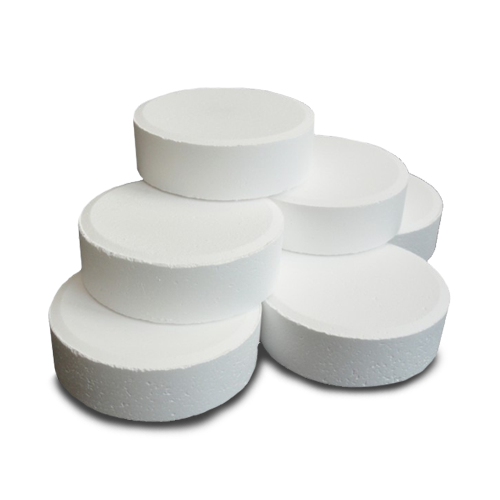


Chlorine Tablet SIZES
Chlorine tablets come in two main sizes: 1 inch and 3 inches
In most cases, you’re best off with 3-inch chlorine tablets, as one single tablet can treat up to 5,000 gallons of water.
On the other hand, 1-inch tablets contain far less chlorine (about half as much as 3-inch tablets), so they’re better suited for smaller indoor pools and spas.
Chlorine Tablet INGREDIENTS
Beyond size, there are also a few other differences between chlorine tablets when it comes to ingredients.
For instance, you’ll notice that certain tablets are labeled as either “stabilized” or “unstabilized”.
This refers to a specific ingredient, known as cyanuric acid (CYA), which helps to shield chlorine from burning up under the sun. Stabilized chlorine contains CYA, which helps it last much longer, and work properly even in sunlight.
Unstabilized chlorine doesn’t contain any CYA at all, which reduces it’s effectiveness and leaves it completely vulnerable to burning away in the sun within hours. Hence why unstabilized chlorine tablets are better suited for indoor pools, where the sun won’t be an issue.
If your pool is outdoors, choose stabilized chlorine tablets.
Certain chlorine tablet manufacturers also include extra chemicals, like algaecides and clarifiers in their products. These are helpful additions, but can always be added separately if needed later. So choose the tablets that fit your needs and budget.
Related: Top 7 Causes of Chlorine Loss & How To Prevent It
What are the best chlorine tablets
Most chlorine tablets will do an equally good job at keeping your pool clean. And that’s because most brands use the same, or similar ingredients in their products. So it mostly comes down to your pool’s specific needs and budget.
But for outdoor pools, as long as you choose 3-inch stabilized tablets, you’re good to go.
On that note, here are a few specific brands of chlorine tablets worth checking out (these aren’t sponsors or partners, just recommendations):
- Pool Time Max Blue 3 inch chlorine tablets
- Clorox Pool and Spa chlorine tablets
- In The Swim 3 inch chlorine tablets
- Swim Best 3 inch Trichlor chlorine tablets
How many chlorine tablets to add to your pool
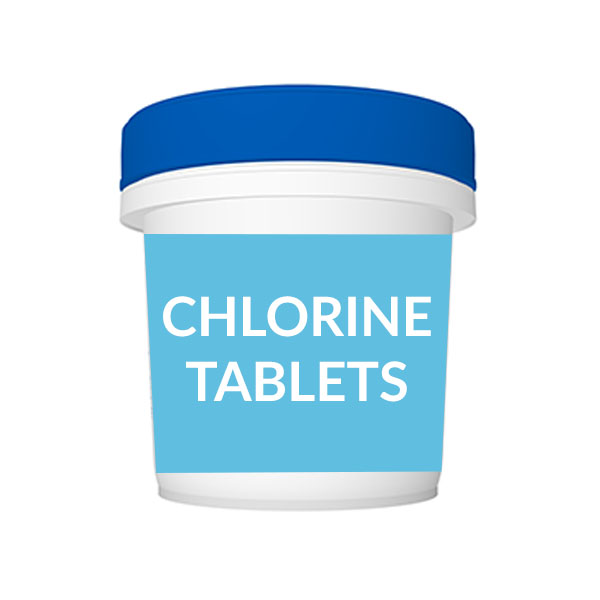


Here’s the question you’ve been waiting to get answered:
How many chlorine tablets should you use?
The answer? It all depends on the size of your pool.
For the best results, use this chlorine tablet dosage chart as a reference:
- 2,500 – 5,000 gallon pools
- 1 chlorine tablet per week
- 7,000-gallon pool
- 1-2 chlorine tablets per week
- 10,000-gallon pool
- 2 chlorine tablets per week
- 13,500-gallon pool
- 2-3 chlorine tablets per week
- 15,000 – 17,000 gallon pools
- 3 chlorine tablets per week
- 20,000-gallon pool
- 3-4 chlorine tablets per week
- 25,000-gallon pool
- 4-5 tablets per week
- 30,000-gallon pool
- 5-6 tablets per week
To keep things easy, remember that a single 3-inch tablet can sanitize up to 5,000 gallons of water. Which means four tablets are enough to sanitize a 20,000-gallon pool.
To calculate how many chlorine tablets to add to your swimming pool, first round your pool’s size (in gallons) to the nearest 5,000th. So if you have a 14,000-gallon pool, you’d round up to 15,000 gallons.
Here’s a little formula to remember: Rounded up Pool Size/5,000=number of chlorine tablets needed
Since a single tablet can treat 5,000 gallons of water, you’d only need 3 tablets to treat up to 15,000 gallons. So you would use 3 tablets for your 14,000-gallon pool.
Using our formula, that would look like this: 15,000 gallons(14,000 rounded up)/5,000 gallons = 3 chlorine tablets
How to add chlorine tablets to your swimming pool
Finally, the most important part of this post – how to add chlorine tablets to your swimming pool.
What do you mean “how to add”, why can’t you just throw them in the water? That’s what they’re made for.
Great point. Yes, chlorine tablets are designed to go in your water. However, they’re not mean to be left dissolving on the floor of your pool.
Why?
Leaving chlorine tablets on the bottom of your pool can cause permanent staining and bleach liners. It’s also the least effective way to use them.
Tablets sitting at the bottom of your pool are nowhere near your pool’s skimmer line. So they dissolve slower and release sanitizer unevenly. When you use chlorine tablets this way, most of the chlorine gets wasted, and you end up having to use even more.
So instead of doing that, here are 4 much better ways to add chlorine tablets to your swimming pool.
Floating dispenser
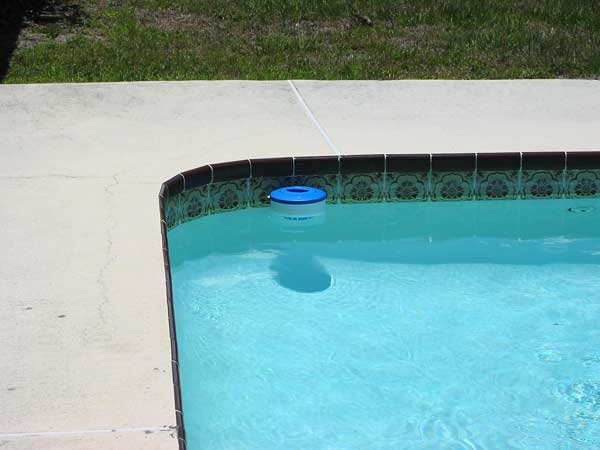


You’ve probably seen this classic pool accessory a few times. You may already be using one now.
They’re the small plastic containers that float on the surface of your water. Sometimes they have funny looking duck or animal on top, other times they’re blue and look like the one in the picture above.
The beauty of floating dispensers lies in their simplicity. They hold just a few tablets and keep them safely contained to gradually dissolve. As the dispenser floats across the surface of your pool, it releases chlorine into your water.
But floating dispensers aren’t perfect. Sometimes, they’ll get stuck in one spot, or trapped in a corner. And since they ‘re completely manual, they don’t float in a particular pattern, which means they don’t always spread chlorine evenly.
So while using a floating dispenser is much better than using nothing at all, it’s not the BEST way to chlorinate your pool.
Skimmer
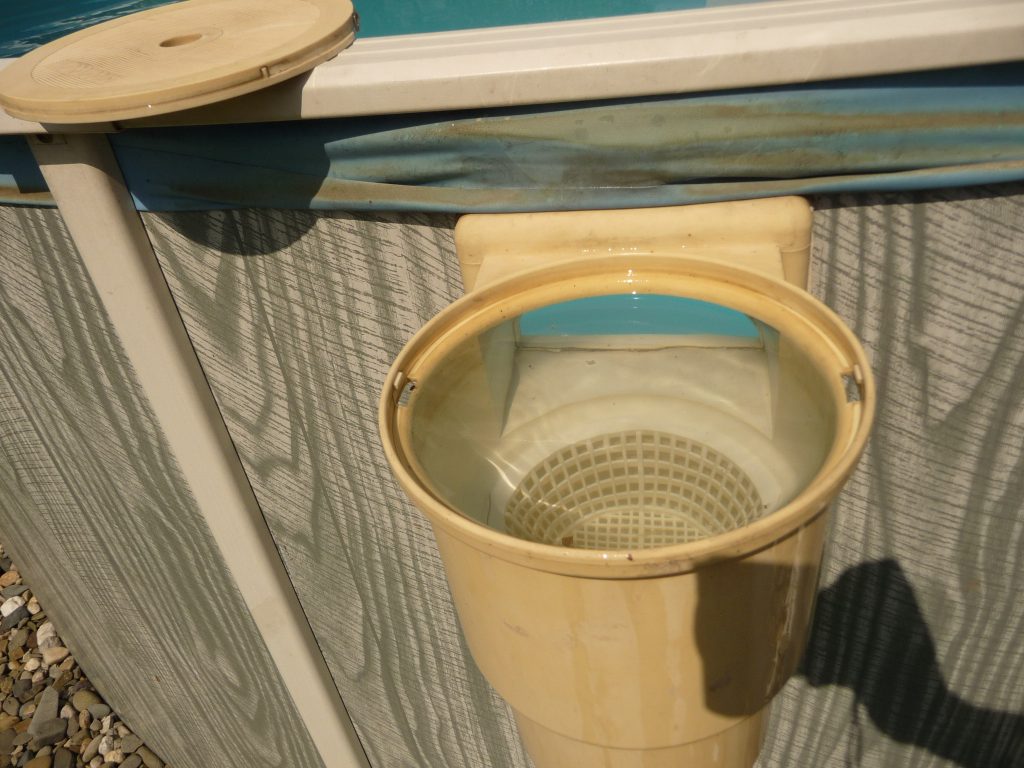


One of the best ways to use chlorine tablets is actually one of the simplest. And it doesn’t require you to purchase anything other than the tablets themselves.
In fact, you already have all the equipment you need.
Your pool skimmer.
While it’s designed to block out and contain loose surface debris, like leaves and bugs, it’s also great for dispensing chlorine.
So if you’ve ever wondered if it’s OK to put chlorine tablets in the skimmer, the answer is yes.
As your pool pump runs, water floats in through your skimmer line, past the pump, into the filter, through the heater, and back into the pool. With a constant stream of water running through it for most of the day, your skimmer offers the perfect spot for both distributing and dissolving the chlorine from your tablets.
And since it’s right in the path of your water flow, your skimmer also spreads chlorine much more evenly than a dispenser ever could.
That said, tablets left in your skimmer will keep dissolving even when your pump isn’t running. If left sitting for a few days, the tablets can create an area of highly concentrated, chlorinated water, which can be corrosive to pool equipment and pipes.
The best way to avoid that is to run your pump on a schedule, or remove tablets once they’re mostly dissolved. If you have a single speed pump, switching to a variable speed pump can lower your energy bill and allow you to affordably keep your filter running.
Automatic chlorinator
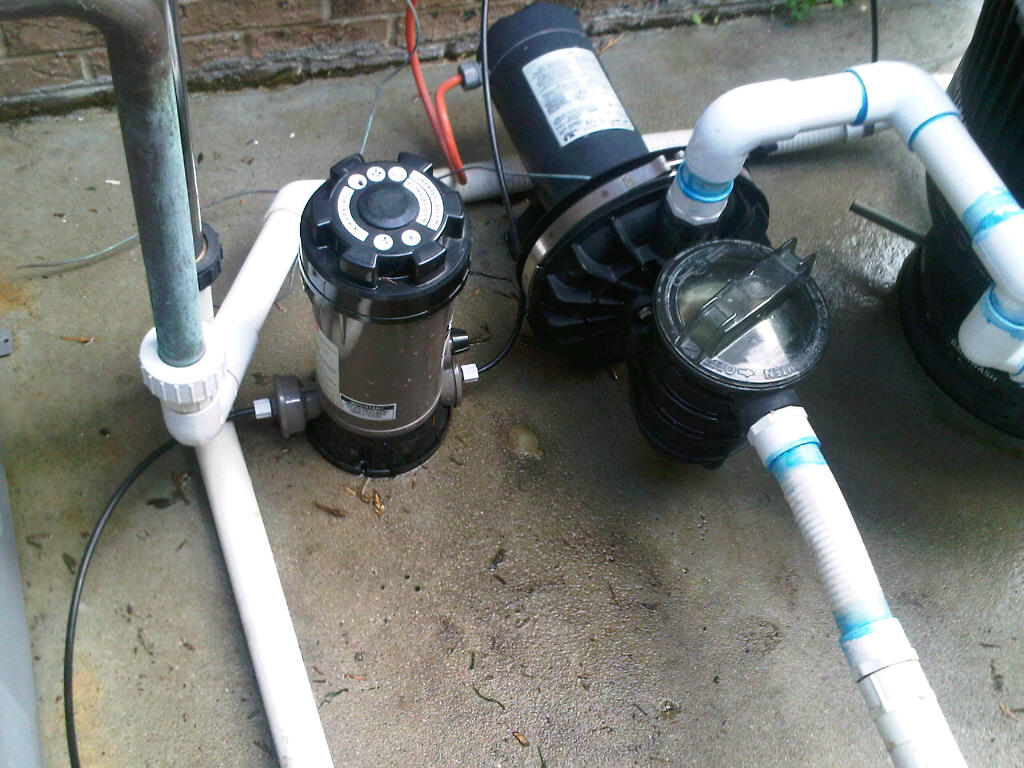


If you’re using chlorine tablets, the best way to do it is with an automatic chlorinator. This special piece of equipment gives you precise control over how much chlorine is fed into your water. It also allows you to control how fast or slow your tablets dissolve.
Essentially, it’s a big container that you fill with chlorine tablets and includes a knob for adjusting feed rate. They’re usually installed at the end of your pool system, right after the heater and before the return line.
With an automatic chlorinator, you load it up, set the feed rate, and enjoy clean water. It saves you the time you’d have to spend adding new tablets each week. Plus, with direct control over chlorine feed rate, you get the most value for your dollar.
Related: 11 Simple Ways To Automate Pool Maintenance
Crushed up (granules)
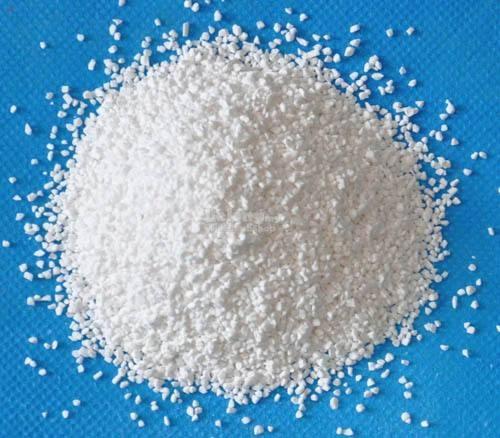


If you’ve ever wondered how granular chlorine or powder chlorine is made, here’s the big reveal.
They’re crushed up tablets.
So if you ever need to quickly chlorinate your pool and are pressed for time, you can crush a few tablets into a fine powder and spread it across your pool. While the chlorine won’t last as long this way, it’ll work faster – perfect for last minute water sanitizing.
Closing thoughts on chlorine tablets
There you have it -everything you need to know about using chlorine tablets. To recap, you typically only need around 2-4 per week, and using them is as simple as adding them to your skimmer. From there, your pool pump does the rest of the work for you.
Of course, always remember to buy the right tablets for your pool size and set up. Overall, 3-inch stabilized chlorine tablets are best for outdoor use, while unstabilized 1-inch tablets are ideal for small indoor pools and spas.
If you liked this post, you might also like:
7 Easy Ways To Lower Chlorine in Your Swimming Pool
21 Pool Maintenance Mistakes That Are Wasting Your Time & Money
Salt Water Pool vs Chlorine Pool: Cost, Differences, Maintenance

